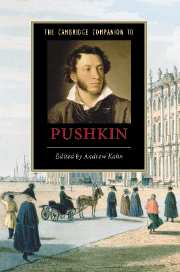Book contents
- Frontmatter
- Introduction
- Part I Texts and Contexts
- 1 Pushkin’s life
- 2 Pushkin’s lyric identities
- 3 Evgenii Onegin
- 4 Pushkin’s drama
- 5 Pushkin’s long poems and the epic impulse
- 6 Prose fiction
- 7 Pushkin and politics
- 8 Pushkin and history
- 9 Pushkin and the art of the letter
- 10 Pushkin and literary criticism
- Part II The Pushkinian tradition
- Appendix on verse-forms
- Guide to further reading
- Index
9 - Pushkin and the art of the letter
from Part I - Texts and Contexts
Published online by Cambridge University Press: 28 March 2007
- Frontmatter
- Introduction
- Part I Texts and Contexts
- 1 Pushkin’s life
- 2 Pushkin’s lyric identities
- 3 Evgenii Onegin
- 4 Pushkin’s drama
- 5 Pushkin’s long poems and the epic impulse
- 6 Prose fiction
- 7 Pushkin and politics
- 8 Pushkin and history
- 9 Pushkin and the art of the letter
- 10 Pushkin and literary criticism
- Part II The Pushkinian tradition
- Appendix on verse-forms
- Guide to further reading
- Index
Summary
Pushkin’s letters are among the most widely read and cited in the Russian epistolary tradition. In reviewing an edition of Voltaire’s correspondence, Pushkin himself gave a psychological rationale for a fascination with an author’s sub-canonical works:
Every line of a great writer becomes precious to posterity … We are involuntarily struck by the thought that the hand which traced these humble figures, these insignificant words, also wrote great works, the objects of our studies and raptures, in the same script and, perhaps, with the same pen.
A writer’s letters (along with other sub-canonical types of writing, such as diaries, notebooks and marginalia) occupy a liminal space on the border of conventional literary and linguistic categories. Letters are written, but it is the oral nature of the genre that is emphasised in the very first lines of traditional manuals on letter writing: 'A letter is a conversation between those who are absent … To write a successful letter, imagine that you are in the presence of the one who will read you, that he is hearing the sound of your voice.'
The need 'to imagine that you are in the presence' of the addressee erodes the borders of individual authorship. In no other type of writing does an author have such strong obligations towards the reader and addressee: a shared frame of reference has to be established, the reader’s opinions taken into account and reactions anticipated. Pushkin was a past master of adjusting to the stylistic expectations of his correspondents, even to the point of mimicking their epistolary 'voices'.
- Type
- Chapter
- Information
- The Cambridge Companion to Pushkin , pp. 130 - 142Publisher: Cambridge University PressPrint publication year: 2006



